|
Victoria Dray's name appeared
in a newspaper list of Iroquois Theater victims the
day after the fire and also in the Everett Marshall
book about the fire. Her name was not included in
the coroner's inquest list, however, nor in
subsequent newspaper coverage and no death
certificate was issued for her.
For other individuals with a conflicting status,
the trail has led sometimes to an Iroquois victim
and other times not, so I set about looking for
signs that Victoria Dray was alive after December
30, 1903.
Fruits of the hunt were so bountiful that it's hard
to decide what to pass along. She had no children,
so there may not be another living person who is
interested in Victoria, but it would be a shame not
to recognize such a character.
Victoria may or may not have attended Mr.
Bluebeard at the Iroquois but definitely did not
die there and was probably not injured. That last
conclusion is based partly on a sense that if
Victoria Dray had lost so much as an eyelash at the
Iroquois, she would have led the fight to prosecute
the theater syndicate.
She was thought to be dead, however, for long enough
that an Iroquois Theater victim's body was
misidentified as Victoria's.
Mary Frazier's body was twice misidentified, once by
a relative of Victoria Dray's and another time by a
relative of
Mary Forbes.
Victoria Clara Guillott (1873–1937) was born in
Vermont to Canadian natives Hubert and Sophia
Guilott. The family moved west and by 1882 lived in
Minneapolis. Victoria remained in the Midwest as an
adult while her parents and some of her five
siblings resettled in Montana.
In 1899 Victoria married her first husband,
commercial realtor, and mortgage holder, Homer Ira
Dray (1872–1901), of Chicago. Homer may have gotten
his start in real estate by working for his uncle,
Walter S. Dray, a Chicago realtor, from the
mid-1880s until his death in 1894. Walter's estate,
adjusted for inflation, would today amount to nearly
$5 million. I was not able to learn how Homer died,
but I am curious, so drop
me a line if you have information about his
death.
No children resulted from Homer and Victoria's
marriage, probably because he died before their
third anniversary, and she did not remarry until she
was forty-five. Victoria's inheritance was
sufficient to let her travel, do a bit of financial
speculation, and maintain homes in several cities,
or so she claimed, so she may have been too busy.
Her 1905 hiring of fifteen-year-old Minnie
Pfannenschmidt may have been born of maternal
yearnings (see below).
Race horse named Venus
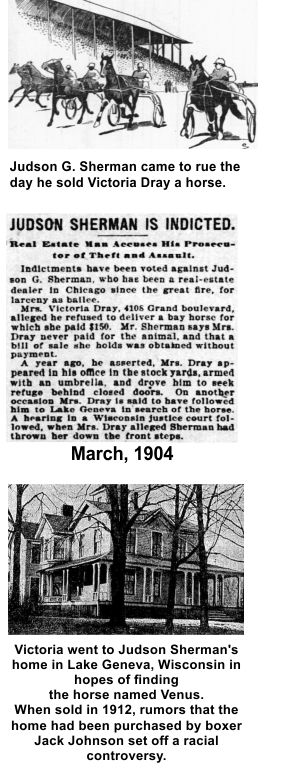
In February, 1903, nine months before the Iroquois Theater opened, Victoria was
making her own drama in Chicago newspapers. She maintained she'd purchased a
horse named Venus for $150 from Judson G. Sherman (1844–1913) who then refused
to produce the horse. A one-time banker, Sherman was treasurer of the National
Horse Sale Company in Chicago, specializing in the sale of harness racing
horses. Judson maintained that Victoria never paid for the horse, that the
receipt she presented was inaccurate because the ownership transfer of Venus
depended upon a real estate transaction that was not completed.
Victoria was having none of it.
She first staged a six-hour sit-in at his office,
refusing to leave and threatening Sherman with her umbrella. While ensconced,
Victoria answered a few of his phone calls, ordered in lunch and made herself an
annoyance until he physically ejected her. The manner of the ejection would
become one of Victoria's several suits against Sherman. The sit-in came to the
attention of the newspaper and the resulting story read like a Lucy Ricardo and
Mr. Moony skit. In 1903 it probably made Victoria a subject for derision.
Undeterred, Victoria spent the next year pursuing Sherman. She went looking for
the horse at his home in Lake Geneva. When she found no Venus she pled her case
to Wisconsin courts and succeeded in seeing Sherman indicted for larceny in
March, 1904. Meanwhile, Victoria brought a $10,000 suit against Sherman for
throwing her down the stairs when he ejected her from his offices in 1903.
Nothing was reported about the conclusion of either case but Sherman's
horse-selling career was not interrupted, so he was not imprisoned, indicating
there was a settlement.
Parental child abuse in 1905

In 1905, Victoria's name again appeared in the newspaper, this time as an accidental
participant in a child abuse case.
Fifty-four-year-old widower, William Pfannenschmidt (1854–1946), who had
immigrated to America from Inbenck, Germany in 1875, earned his living selling
oil door to door. His second wife died in 1903, soon after their wedding,
leaving him with six children aged four to fourteen.
Four of the Pfannenschmidt children remained at home in 1905 when William
Pfannenschmidt went to Nebraska to find a homestead. He left his
fifteen-year-old daughter, Helen, nicknamed "Minnie," in charge of the
household, including the garden and her three younger siblings, aged nine to
twelve.
Victoria Dray lived near Minnie but not close enough to easily explain how they came to
know one another. However they became acquainted, the result was that Victoria
hired Minnie to work for her — in an unknown capacity but presumably as a
domestic — in exchange for clothing and an unreported amount of money. Such
arrangements were common in the early 1900s when children were sometimes viewed
as laborers.
When William returned from Nebraska and learned Minnie had not done as
instructed, he beat her with his fists, whipped her with a belt, and kicked her.
Minnie fled and went to the Friends of the Homeless, who reported the abuse to
the police. William was arrested and his case was heard by judge Healy.
"My father pounded me with his fists and kicked me," she said to Judge Healy. "I
worked as hard as I could and tried to keep the house clean for him." Pfannenschmidt
was fined, Minnie Pfannenschmidt remained with Friends of the
Homeless, her eleven-year-old sister Annie Helen Pfannenschmidt went to live
with an older married sister, Emma.
The two boys, nine-year-old Charles and twelve-year-old Fritz, remained with
their father. William remarried two years later to his third wife,
forty-eight-year-old widow, Mary Collins, becoming stepfather to Mary's
fifteen-year-old daughter, Susie Collins.
The story of the Pfannenschmidts doesn't end just yet. Three weeks after the wedding, Mary
died under circumstances that a neighbor, family priest, and her daughter Susie
found suspicious. They thought William had poisoned Mary for her small nest egg
and had possibly done the same to his prior wife.
Police and the coroner's office investigated and found nothing to suggest Mary
did not die of natural causes. The following year William married a fourth time,
but that wife too would be gone when he died in 1946 at age ninety-two.
Nothing was reported about what happened to Susie Collins. Hopefully, the courts
did not force her to return to the home of a man with a history of violence whom
she'd accused of murder.
And what became of Minnie? By 1940 she was widowed and worked as a cook —
living with the father who had beaten her thirty-five years before.
Victoria tries on a millinery enterprise
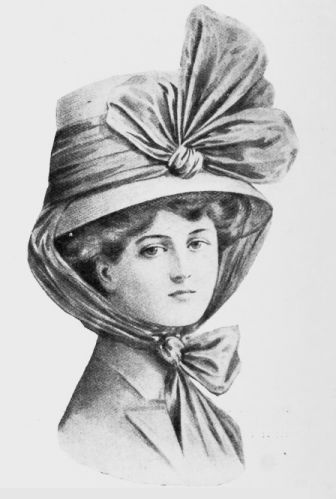
Just a period-appropriate illustration of a woman wearing a hat,
not Minnie or Victoria.
In 1907 Victoria incorporated the Victoire millinery
company in New York with V. Mayne Turner, Alexander S. Bacon, and herself as
directors. A year later, it was reorganized with
herself as president, Mabel Dickinson as secretary,
and Alexander S. Bacon as a director.
|

|
Initial capitalization was $2,000. Other than incorporation filings, I found no evidence
of business activity. Alexander Samuel Bacon was an author, and V. Mayne Turner
owned the copyright on one of Bacon's books. In 1916 the pair formed a
partnership in a printing firm.
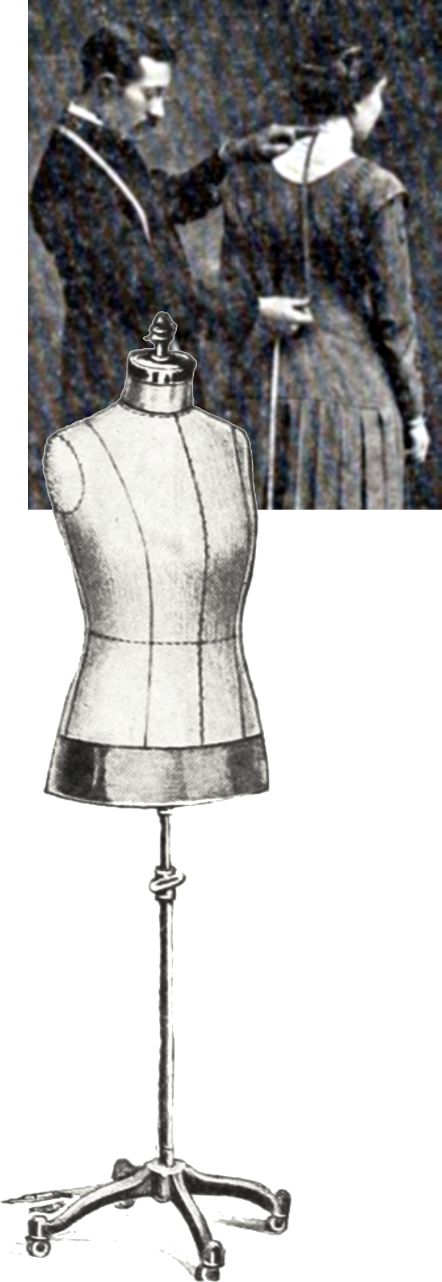
Victoria back in court, wins suit against Lithuanian
In 1908 Victoria brought suit against a Chicago tailor
for refusing to reduce his bill for dresses she maintained fit poorly. Reported
as George Gansky, the tailor may have been twenty-nine-year-old Joe Ghenski, who
lived on Ellen St. with twelve other Lithuanian and Russian tailors and
seamstresses.
Victoria likely cited expert knowledge as her father and brother were tailors.
Municipal Civil court judge of the First District, Edwin K. Walker (186_–1953),
had Victoria don two of the four dresses she purchased and ruled that one was an
inch too long and the other an inch too loose at the waist. Walker ordered the
tailor to turn over all four dresses and reduce his bill by $12 (another paper
reported $22). Victoria gloated to the press.
Stakeouts, wanted posters, burglary and lies bring Victoria a third win in the courts.
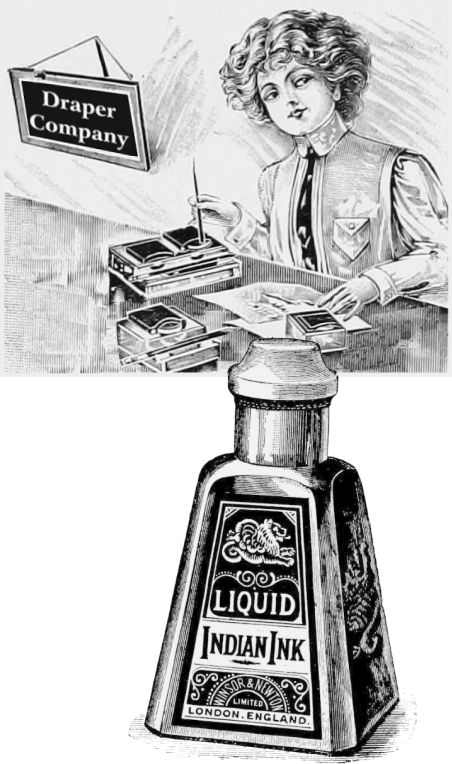
In 1910 Victoria spent much
of the year in Detroit courts pursuing officers of
the Draper Company Ltd. She wanted compensation for
the job she claimed they'd offered and return of her
$1,000 investment.
Victoria went after three of its founders: Arthur
Wellington Draper, John D. Kuppenheimer (known as
the Prince of Bu) of the Oriental Silk
Company of Montreal, and John's brother, Jacob D.
Kuppenheimer.
The Draper Company had been incorporated in 1909 to
manufacture indelible ink and carbon paper, with a
head office in Detroit. Victoria contributed $1,000
to their original $100,000 in capital. She asserted
that Kuppenheimer also promised her a job as a
traveling sales representative with a $40 weekly
salary.
When the company and job failed to materialize, and
Kuppenheimer denied having made the job offer,
Victoria hired an attorney — and went to work
herself on a variety of schemes to bring pressure on
the plaintiffs:
-
When Draper evaded an arrest warrant, Victoria had fliers printed that
pictured the principals in the company and offered $200 for information about their
whereabouts. Newspaper reports did not state how many fliers were printed or how Victoria managed
the distribution, but Draper's wife came across one of the fliers while traveling in England.
-
When Victoria learned that Draper was back in Detroit and planned to
escape again, she hired a taxi and did stakeouts
at various train depots until she spotted him.
She summoned a policeman, and Draper was arrested.
-
A dramatic courtroom moment came when Victoria submitted copies of
letters that overnight had disappeared from
Draper's office. Newspapers did not report
whether Victoria pulled off the document heist
by herself or hired a burglar.
In court records, she reported corset modeling as her occupation, for
the American Lady Corset Company. I checked decades
of ALC advertisements, but all incorporated stylized
illustrations of young ingénues, and I found nothing
to corroborate Victoria's involvement with the
company. At thirty-seven, she probably no longer had
a look the company favored, but the company did have
a line of models for fuller figures.
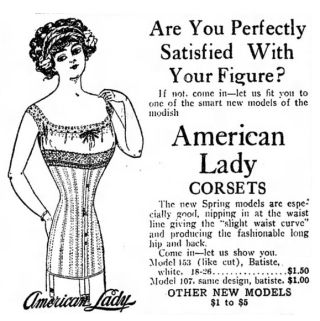
In any case, for Victoria,
there were always alternate facts. When it became important in
prosecuting the case against Draper for her to be a
Michigan resident, Victoria testified that she had
always had a residence in Detroit. She must have
meant except for from 1899 to at least 1907 when she
lived in Chicago. Had someone checked, they would
have learned, that the only Dray in Detroit
City directories 1907-1915 was a single man.
Victoria Dray's name did not appear until 1916 (but
I could not find her in the 1910 US Census, so she
may have been in Detroit, but the directories missed
her — for a decade). At other times she claimed to
have residences in Chicago, Manhattan, and Paris. I
don't know about Paris ,but in Chicago and
Manhattan, her residence consisted of a room in a
boarding house.
Kuppenheimer hit back with numerous countersuits,
but in the end, there was a settlement returning
Victoria's $1,000 investment plus $1,000 for her
trouble.
Victoria moves to Michigan, becomes Victoria Clara Guillott Dray
Lebert
Victoria lived in Michigan the last two decades of
her life, operating the Antler's Stag Hotel and cafe
and marrying in 1918 and again in 1925.
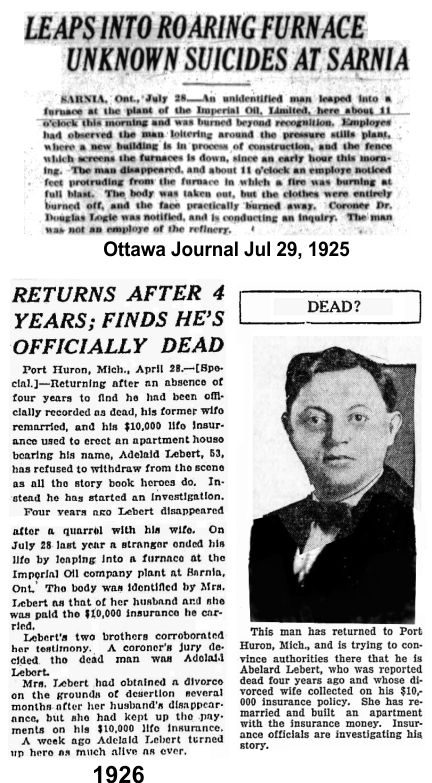
Second husband
In 1918 she married Canadian,
Adelard Lebert (1883–___), age thirty-five, and the
pair settled in Port Huron, Michigan. Four years
into the marriage, Adelaid disappeared after he and
Victoria argued (perhaps about her having claimed
she was only thirty-five at the time of their
marriage instead of her actual forty five), and did
not return home. Victoria filed for desertion a few
months later but continued making payments for the
next three years on his two life insurance policies
for coverage totaling over $8,000. While watching, I
suspect, for news of a death that met her purposes,
i.e., one involving an unrecognizable and
unidentified male corpse within a short distance of
Port Huron.
Having been briefly thought an Iroquois
theater victim herself, Victoria would have followed
Iroquois news closely and known about the various
miss identifications of badly burned bodies. Thus a
story in July 1925 of a horrific suicide may have
been just what she was looking for. Across the St.
Clair River in Sarnia, Ontario, an unidentified man
jumped into a flaming furnace at Imperial Oil
Limited and was burned beyond recognition with only
a portion of the face remaining.
He wasn't dead
Victoria came forward to identify the body as her
missing husband, Adelard Lebert. Corroborating
identifications from Adelaid's two brothers
convinced the coroner, Dr. Douglas Logie, who issued
the death certificate for Adelard Lebert. The Lebert
brothers paid for funeral services, and Victoria got
the death certificate she needed to collect the life
insurance payout. She used the $8,000 to build an
apartment building, even naming the building Adelard
Apartments.
The following year Adelard Lebert turned up very
much alive. He had been traveling in California,
Washington, and Florida for the past four years.
Upon returning to the area, presumably to visit
family in Ontario, he learned of his supposed death
and thought his brothers should be reimbursed for
the funeral expenses of the stranger they'd buried.
The insurance company tried to force Victoria to
return the money, but she denied that the man who
claimed to be Lebert was her husband. Victoria
challenged the insurance company and assistant
prosecutor in Port Huron, Jesse Wolcott, to prove
that the man who claimed to be Adelard was actually
her husband — accurately calculating that they would
not, or could not, do so. Adelard's parents were
deceased. There were siblings who could have
identified him, but the situation called for people
who could connect Adelard to Victoria, and it's
possible they all lived in Canada. Bringing them
across the border to testify may have been
problematic.
For his part, Adelard laid no claim to the insurance
money. Presumably, he had not paid the premiums on
the policies prior to his disappearance in 1922.
Whatever the considerations, the case was dropped.
Victoria kept her apartment house.
In 1925 at age fifty-two, Victoria married a third
time to a retired contractor in Port Huron, an
eighty-year-old widower named William Manley
(1845–1927). It was reported that Manley had been a
friend of Adelard Lebert. I failed to find online
information about William Manley's will.
Victoria buried in an unmarked grave
Victoria died at age sixty-two in 1937 of ovarian
cancer. She was buried in an unmarked grave at the
Lakeside Cemetery in Port Huron, Michigan, alongside
her third husband, William Manley, and his first
wife. (Semper fi, Mr. Lindsay.)
|
